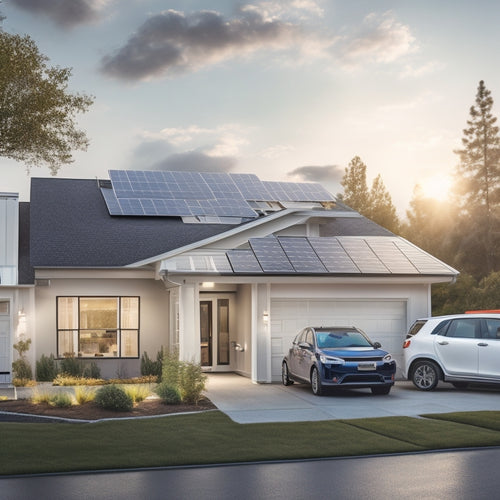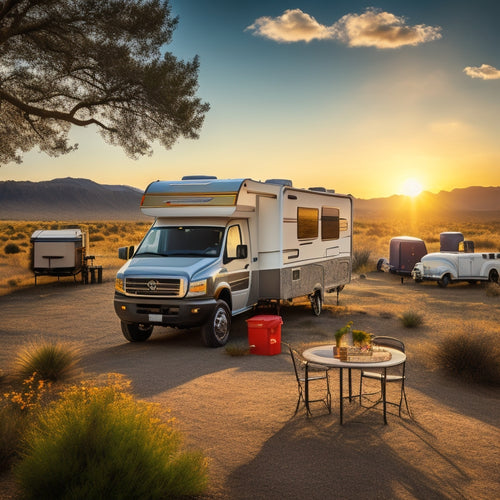
Set Up an Off Grid Solar Power System for Your Home in 3 Steps
Share
You'll start by evaluating your energy needs, tracking your daily consumption patterns to identify total power generation requirements and estimating daily usage hours for each device. Next, you'll choose the right system components, selecting suitable solar panels, batteries, and an inverter that match your system's voltage and power requirements. Finally, you'll install and connect the system, optimizing panel placement, following manufacturer's instructions, and guaranteeing proper wiring and safety precautions. Once you've completed these three steps, you'll be well on your way to utilizing the power of solar energy – and there's more to investigate to guarantee a seamless and efficient changeover.
Key Takeaways
- Assess your energy needs by tracking consumption patterns and estimating daily usage hours for each device to calculate total daily energy consumption.
- Choose suitable system components, including solar panels, batteries, and an inverter, considering factors like efficiency, durability, and capacity.
- Optimize solar panel placement, ensuring proper inverter and battery installation, and follow safety precautions when working with electrical systems.
- Ensure accurate system sizing by calculating total daily energy needs and selecting components that meet those requirements.
- Consider professional assistance if needed, and follow manufacturer's instructions for proper installation, maintenance, and charging of system components.
Assess Your Energy Needs
To determine the size of your off-grid solar power system, you need to calculate your daily energy requirements. This involves tracking your energy consumption patterns to identify the total amount of power you need to generate.
Start by making a list of all your appliances, lights, and devices, along with their respective power ratings. Then, estimate the number of hours each device will be used daily. Multiply the power rating by the usage hours to get the total daily energy consumption in watt-hours (Wh).
Add up the energy requirements of all devices to get your total daily energy needs.
Consider your power sources, such as refrigeration, lighting, and entertainment. Identify areas where you can reduce energy consumption by using energy-efficient alternatives. This will help you optimize your system's performance and reduce your reliance on non-renewable energy sources.
Choose Your System Components
Now that you've assessed your energy needs, you're ready to select the components for your off-grid solar power system. This is a vital step, as the right components will guarantee your system meets your energy requirements efficiently and effectively.
You'll need to choose the right solar panel types for your system. Monocrystalline panels offer high efficiency, while polycrystalline panels are more budget-friendly. Thin-film panels are another option, but they're less efficient.
Consider factors like panel size, wattage, and durability when making your decision.
Next, you'll need to select suitable battery options. Deep cycle batteries, like lead-acid or lithium-ion, are designed for off-grid systems and can handle repeated charging and discharging.
Consider the battery's capacity, depth of discharge, and lifespan when choosing the right one for your system. Additionally, you'll need an inverter to convert DC power from the solar panels to AC power for your home.
Be sure to select an inverter that matches your system's voltage and power requirements.
Install and Connect System
With your system components in hand, it's time to bring your off-grid solar power system to life by installing and connecting each piece. This step requires attention to detail and adherence to safety precautions to guarantee a functional and efficient system.
Installation Checklist
| Component | Installation Tips |
|---|---|
| Solar Panels | Optimize solar panel placement for maximum energy output, considering shading, orientation, and tilt. |
| Inverter | Select an inverter that matches your system's voltage and power requirements, and follow the manufacturer's wiring techniques. |
| Battery Storage | Confirm proper battery storage by following the manufacturer's instructions for installation, maintenance, and charging. |
| Wiring | Use proper wiring techniques and materials to connect components, and consider hiring a professional if you're unsure. |
Remember to follow safety precautions when working with electrical systems, such as wearing protective gear and turning off power sources before starting work. By carefully installing and connecting each component, you'll be one step closer to enjoying the benefits of off-grid solar power in your home.
Frequently Asked Questions
Can I Install an Off-Grid Solar System Myself?
You can attempt a DIY installation, but it's essential to guarantee you're familiar with solar system components, including panels, inverters, and batteries, to avoid safety risks and optimize performance; consider consulting a professional for a hassle-free experience.
How Long Does an Off-Grid Solar System Last?
You'll be impressed to know that a well-maintained off-grid solar system can last up to 30 years or more. To guarantee that, you'll need to perform regular maintenance, such as cleaning panels and replacing batteries, to maximize your system's lifespan.
Can I Add More Panels to My System Later?
You can easily add more panels to your system later, guaranteeing panel compatibility and seamless system expansion, as long as you've chosen a scalable setup and consulted with a professional to guarantee a smooth integration process.
Do Off-Grid Solar Systems Work During Power Outages?
You'll be glad to know that off-grid solar systems continue to provide power during outages, ensuring system reliability and energy independence, so you can stay connected and comfortable, even when the grid fails.
Will My Off-Grid Solar System Increase My Property Value?
When you invest in an off-grid solar system, you're likely to enhance your property value, as a property appraisal will reflect the added value of energy independence, making your home more attractive to potential buyers who crave self-sufficiency.
Conclusion
You've taken the leap to utilize the sun's energy! Now, your off-grid solar power system is up and running, illuminating your path to independence. As you bask in the glow of self-sufficiency, remember that regular maintenance is key to keeping your system shining bright. Stay on top of battery checks, panel cleaning, and inverter monitoring to guarantee your new setup continues to power your life, unencumbered by the grid.
Related Posts
-

What Electric Vehicle Owners Need for Home Energy
As an electric vehicle owner, you need to optimize your home energy system to guarantee efficient, sustainable, and c...
-

What You Need to Know About RV Solar Maintenance
When you're out on the road, your RV's solar panel system is your lifeline. But without regular maintenance, you're l...
-

Why Invest in Residential Solar Panel Systems?
By investing in a residential solar panel system, you'll harness renewable energy, reducing your carbon footprint and...


